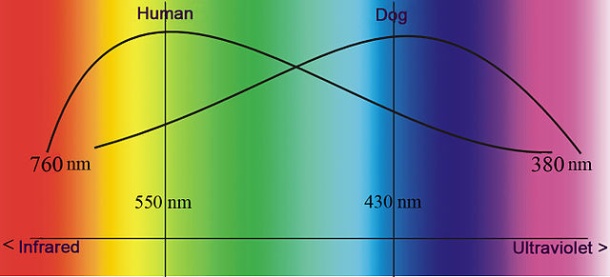Are dogs colorblind? Yes, although not in the way most people think.

Color perception Dogs compared with Humans
‘Colorblind’ is a somewhat subjective term biased toward trichromatic vision–the kind of sight most human beings enjoy. But our electromagnetic range is not the pinnacle of color perception. From a bird’s perspective, it is humans that are colorblind–we could never perceive the vast complexity of hues available to denizens of the air.
Similarly, dogs could never perceive all the colors humans see, but that doesn’t mean they see all in black-and-white; it just means their palette is more limited than that of humans. This is also the case with people who are colorblind. True monochromatism–100 percent grayscale–is very rare. The vast majority of chromatically-challenged people have the milder red-green colorblindness, a perspective they share with canines.
As Different As Night and Day

Are dogs color blind? If the dogs were the scientists in this scenario, they would undoubtedly ask if humans are ‘motion-blind’ or perhaps ‘brightness-blind.’ Those are the features of light our eyeballs miss in order to see colored details with precision. While human perception depend heavily on color, dogs depend most on motion, brightness and shape.
Where did these differences come from? They developed along the divergent evolutionary pathways of nocturnal and diurnal species. Nocturnal creatures sleep during the day and feed at night; for diurnal creatures, just the opposite is true. Diurnal humans are therefore equipped to see better during the daytime. For nocturnal hunting creatures like dogs, daytime color saturation is nonessential. At night, eyes tuned to fine gradations in brightness and motion through space confer the competitive advantage.
As long as the light is bright, detail-oriented humans see better than dogs. Once dusk falls, however, it is dogs that have the superior vision. Their light-sensitive eyeballs can distinguish shifting shadows and complex patterns in poor lighting which are largely invisible to their human companions. Dogs see best when the distracting rainbow of colors is displaced by different luminosities in a grayed-out field of vision–making the flight of prey in the colorless night easier to detect.
Dog’s Eye View
What colors does a dog perceive? The dog’s day is painted in yellow-greenish-brownish shades combined with flat-toned blues and grays. Greens are dark and neutral to dogs, and blue-green is bleached out. Because purple is a combination of blue and red, red-deficient dogs simply see purple as blue.
In fact, the whole cool side of the color spectrum folds into gray-blues, while the warm side–reds and oranges–loses its warmth entirely. In other words, the day is soaked in a kind of fixed twilight, the yellow-blue of a cool evening folding into night.
The overall effect for dogs during daylight hours is a fuzzier, faded, yet brighter picture of things. As one expert put it, dogs see through a lens not unlike “a piece of cellophane that has been smeared with a light coat of petroleum jelly.”
To a dog, fire hydrants aren’t red but a rather blaise pea soup tint. Similarly, bright orange or red toys may seem to make a good contrast with your lawn, but what stands out to you blends right in to Fido. The red and green just look like similar shades of olive.
Pawblo Picasso
Being colorblind definitely has its merits once the sun goes down. Even though dogs can’t tell the difference between a lemon and a lime in full light, they can expertly discriminate among objects barely illuminated by the moon. Moreover, Canis familiaris isn’t fooled by trichromat visual tricks like camouflage which rely on color deception.
The same can be said of red-green colorblind people. These folks have something of a hunter’s edge over ordinary people, although they are out of luck at traffic lights that require drivers to discriminate between red and green, and thus ‘stop’ and ‘go.’ When guide dogs must safely lead the blind across busy intersections, they don’t check the color of signals, but instead use their keen sense of hearing to perceive the flow of traffic.
Many of history’s most innovative painters had a finely tuned sensibility to the properties of light and pigment perceived by dogs. Monet, for instance, was able to capture visuals with unparalleled unity and depth by adopting a ‘colorblind’ perspective, focusing on contours, patterns and textures normally eclipsed by the riot of color. Perhaps if dogs had opposable thumbs with which to grasp paintbrushes, they would be counted among the world’s greatest visual artists.